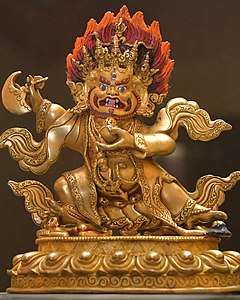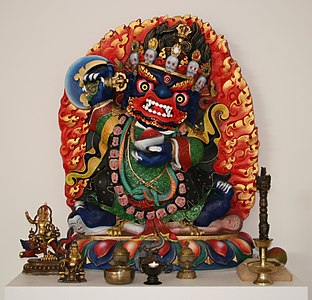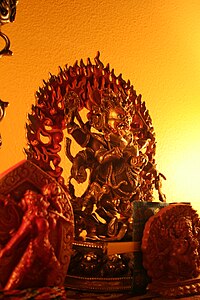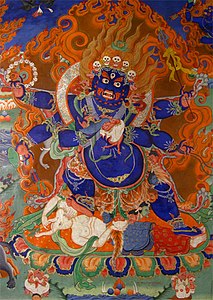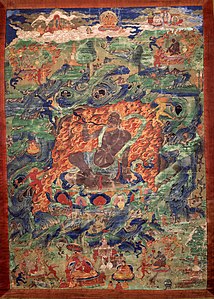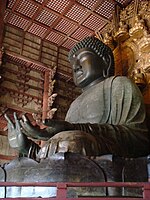
Mahakala
| Mahakala | |
|---|---|
God of Time, Maya, Creation, Destruction and Power | |
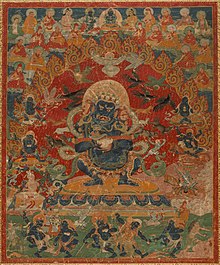 Mahākāla and companions
| |
| Affiliation | Shiva |
| Abode | Śmaśāna (but varies by interpretation) |
| Weapon |
Khanda, Trishula, Hammer (in Japanese depictions) |
| Consort | Parvati as Mahakali |
Mahākāla is a deity common to Hinduism and Tantric Buddhism. In Buddhism, Mahākāla is regarded as the sacred Dharmapāla ("Protector of the Dharma"), while in Hinduism, Mahākāla is a fierce manifestation of the Hindu god Shiva and the consort of the goddess Mahākālī; he most prominently appears in the Kalikula sect of Shaktism. Mahākāla also appears as a protector deity in Vajrayana, Chinese Esoteric, and Tibetan Buddhism (see Citipati), and also in the Chàn and Shingon traditions. He is known as Dàhēitiān and Daaih'hāktīn (大黑天) in Mandarin and Cantonese, Daeheukcheon (대흑천) in Korean, Đại Hắc Thiên in Vietnamese, and Daikokuten (大黒天) in Japanese.
Etymology
Mahākāla is a Sanskrit bahuvrihi of mahā "great" and kāla "time/death", which means "beyond time" or death.
Tibetan: ནག་པོ་ཆེན་པོ།, THL: nak po chen po means "Great Black One". Tibetan: མགོན་པོ།, THL: gön po "Protector" is also used to refer specifically to Mahākāla.
Description

According to Shaktisamgama Tantra, the spouse of Mahākālī is extremely frightening. Mahākāla has four arms, three eyes and is of the brilliance of 10 million black fires of dissolution, dwells in the midst of eight cremation grounds (śmaśāna). He is adorned with eight human skulls, seated on five corpses, holds a trident (triśūla), a drum, a sword, and a scythe in his hands. He is adorned with ashes from the cremation ground and surrounded by numbers of loudly shrieking vultures and jackals. At his side is his consort, symbolized as Kālī.
Both Mahākāla and Kālī represent the ultimate destructive power of Brahman and they are not bounded by any rules or regulations. They have the power to dissolve even time and space into themselves, and exist as the Void at the dissolution of the universe. They are responsible for the dissolution of the universe at the end of each kalpa. They are also responsible for annihilating great evils and great demons when other Gods, Devas, and even Trimurtis fail to do so. Mahākāla and Kālī annihilate men, women, children, animals, the world, and the entire universe without mercy because they are Kala or Time in the personified form, and Time is not bound by anything, and Time does not show mercy, nor does it wait for anything or anyone. In some parts of Odisha, Jharkhand, and Dooars (that is, in eastern Bengal), wild elephants are worshiped as manifestations of Mahākāla.
Mahākāla is typically depicted blue or black in colour. Just as all colours are absorbed and dissolved into black, all names and forms are said to melt into those of Mahākāla, symbolising his all-embracing, comprehensive nature. Black can also represent the total absence of colour, and again in this case it signifies the nature of Mahākāla as ultimate or absolute reality. This principle is known in Sanskrit as nirguna, beyond all quality and form, and it is typified by both interpretations.
In Hinduism
Mahakala is also known as Mahakala Bhairava in Hinduism, and many temples in India and Nepal are dedicated solely for Mahakala Bhairava, for example at the temple in Ujjain, which is mentioned more than once by Kālidāsa. The primary temple, place of worship for Mahakala is Ujjain. Mahakala is also a name of one of Shiva's principal attendants (Sanskrit: gaṇa), along with Nandi, Shiva's mount and so is often represented outside the main doorway of early Hindu temples.
In Buddhism
In Tibet
Mahayana Buddhism, and all schools of Tibetan Buddhism, rely on Mahakala as guardian deity. He is depicted in a number of variations, each with distinctly different qualities and aspects. He is also regarded as the emanation of different beings in different cases, namely Avalokiteśvara (Wylie: spyan ras gzigs) or Cakrasaṃvara (Wylie: ’khor lo bde mchog). Mahakala is almost always depicted with a crown of five skulls, which represent the transmutation of the five kleśās (negative afflictions) into the five wisdoms.
The most notable variation in Mahakala's manifestations and depictions is in the number of arms, but other details can vary as well. For instance, in some cases there are Mahakalas in white, with multiple heads, without genitals, standing on varying numbers of various things, holding various implements, with alternative adornments, and so on.
Two-armed forms
The two-armed "Black-Cloaked Mahakala" (Wylie: mgon po ber nag chen) is a protector of the Karma Kagyu school clad in the cloak of a māntrika "warlock". His imagery derives from terma of the Nyingma school and was adopted by the Karma Kagyu during the time of Karma Pakshi, 2nd Karmapa Lama. He is often depicted with his consort, Rangjung Gyalmo. He is often thought to be the primary protector, but he is in fact the main protector of the Karmapas specifically. Four-Armed Mahakala is technically the primary protector. Six-Armed Mahakala (Wylie: mgon po phyag drug pa) is also a common dharmapala in the Kagyu school.
Pañjaranātha Mahakala "Mahakala, Lord of the Tent", an emanation of Mañjuśrī, is a protector of the Sakya school.
Four-armed forms
Various Four-Armed Mahakalas (Skt. Chaturbhūjamahākāla, Wylie: mgon po phyag bzhi pa) are the primary protectors of the Karma Kagyu, Drikung Kagyu, Drukpa Lineage and the Nyingma of Tibetan Buddhism. A four-armed Mahakala is also found in the Nyingma school, although the primary protector of the Dzogchen (Skt: Mahasandhi) teachings is Ekajati.
Mahakala, 12th century, Rubin Museum of Art
Six-armed forms
Nyingshuk came from Khyungpo Nenjor, the founder of the Shangpa Kagyu, and spread to all the lineages (Sakya, Nyingma, and Gelug) and to the Kagyu lineages. There are also terma lineages of various forms of Six-Armed Mahakala. Nyinghsuk, though derived from the Shangpa, is not the major Shangpa one; it is in a dancing posture rather than upright, and is a very advanced Mahakala practice. The White Six-Armed Mahakala (Skt: Ṣadbhūjasītamahākāla; Wylie: mgon po yid bzhin nor bu) is popular among Mongolian Gelugpas.
Other forms
In China
Mahākāla is mentioned in many Chinese Buddhist texts, although iconographic depictions of him in China were rare during the Tang and Song periods. He eventually became the center of a flourishing cult after the 9th century in the kingdoms of Nanzhao and Dali in what is now the province of Yunnan, a region bordering Tibet, where his cult was also widespread. Due to Tibetan influence, his importance further increased during the Mongol-led Yuan dynasty, with his likeness being displayed in the imperial palace and in Buddhist temples inside and outside the capital. The deity's name was both transcribed into Chinese characters as 摩訶迦羅 (pinyin: Móhējiāluó; Middle Chinese (Baxter): mwa xa kæ la) and translated as 大黑天 (pinyin: Dàhēitiān; lit. 'Great Black Deva', with kāla being understood to mean 'black'; M. C. (Baxter): dɑH xok then).
In some texts, Mahākāla is described as a fearsome god, a "demon who steals the vital essence (of people)" and who feeds on flesh and blood, though he is also said to only devour those who committed sins against the Three Jewels of Buddhism. One story found in the Tang-era monk Yi Xing's commentary on the Mahāvairocana Tantra portrays Mahākāla as a manifestation of the buddha Vairocana who subjugated the ḍākinīs, a race of flesh-eating female demons, by swallowing them. Mahākāla released them on the condition that they no longer kill humans, decreeing that they could only eat the heart - believed to contain the vital essence of humans known as 'human yellow' (人黄, pinyin: rénhuáng) - of those who were near death. A tale found in Amoghavajra's translation of the Humane King Sūtra relates how a heterodox (i.e. non-Buddhist) master instructed Prince Kalmāṣapāda (斑足王) to offer the heads of a thousand kings to Mahākāla, the "great black god of the graveyard" (塚間摩訶迦羅大黑天神), if he wished to ascend the throne of his kingdom.
As time went by, Mahākāla also became seen as a guardian of Buddhist monasteries, especially its kitchens. The monk Yijing, who traveled to Srivijaya and India during the late 7th century, claimed that images of Mahākāla were to be found in the kitchens and porches of Indian Buddhist monasteries, before which offerings of food were made:
There is likewise in great monasteries in India, at the side of a pillar in the kitchen, or before the porch, a figure of a deity carved in wood, two or three feet high, holding a golden bag, and seated on a small chair, with one foot hanging down towards the ground. Being always wiped with oil its countenance is blackened, and the deity is called Mahākāla [莫訶哥羅, pinyin: Mòhēgēluō, M.C. (Baxter): mak xa ka la] or the great black deity [大黑神, pinyin: Dàhēishén, M. C. (Baxter): dɑH xok zyin]. The ancient tradition asserts that he belonged to the beings (in the heaven) of the great god (or Maheśvara). He naturally loves the Three Jewels, and protects the five assemblies from misfortune. Those who offer prayers to him have their desires fulfilled. At meal-times those who serve in the kitchen offer light and incense, and arrange all kinds of prepared food before the deity. (...) In China the image of that deity has often been found in the districts of Kiang-nan, though not in Huai-poh. Those who ask him (for a boon) find their wishes fulfilled. The efficacy of that deity is undeniable.
In China, the god was also associated with fertility and sexuality: during the Qixi Festival (a.k.a. the Double Seventh Festival) held on the 7th day of the 7th month of the Chinese calendar, married women traditionally bought dolls or figurines called 'Móhéluó' (魔合羅) or 'Móhóuluó' (摩睺羅) - the term probably deriving from 'Mahākāla' - in the hopes of giving birth to a child. Ritual texts also prescribe the worship of Mahākāla to women looking for a male partner or to pregnant women. In addition, he is also commonly invoked as a protective deity in certain mantras, such as the Śūraṅgama Mantra and the Mahamayuri-vidyarajñi-dharani contained in the Mahamayuri Vidyarajñi Sutra, which are popular in Chan Buddhism tradition.
Dàhēitiān (center) flanked by the bodhisattvas Samantabhadra (left) and Mañjuśrī (right). Baocheng Temple, Hangzhou, Zhejiang, China
Qing dynasty statuette of Dàhēitiān. China, 17th Century
Ming dynasty statue of Dàhēitiān. Sichuan, China. 14th Century (with pedestal from the 16th century)
In Japan
Mahakala (known as Daikokuten 大黑天) enjoys an exalted position as a household deity in Japan, as he is one of the Seven Lucky Gods in Japanese folklore.
The Japanese also use the symbol of Mahakala as a monogram. The traditional pilgrims climbing the holy Mount Ontake wear tenugui on white Japanese scarves with the Sanskrit seed syllable of Mahakala.
In Japan, this deity is variously considered to be the god of wealth or of the household, particularly the kitchen. He is recognised by his wide face, smile, and a flat black hat, in stark contrast to the fierce imagery portrayed in Tibetan Buddhist art. He is often portrayed holding a golden mallet, otherwise known as a magic money mallet, and is seen seated on bales of rice, with mice nearby (mice signify plentiful food).
See also
Citations
Works cited
- Amoghavajra (n.d.). "仁王護國般若波羅蜜多經 護国品第五 - T. 0246". SAT Daizokyo Text Database. Retrieved 2021-04-21.
- Bhattacharya Saxena, Neela (2011). "Gynocentric Thealogy of Tantric Hinduism: A Meditation Upon the Devi". Oxford Reference. Oxford: Oxford University Press. pp. 131–156. doi:10.1093/oxfordhb/9780199273881.003.0006. ISBN 978-0199273881. (subscription or UK public library membership required)
- Bowker, John (2000). "The Concise Oxford Dictionary of World Religions". Oxford Reference. Oxford: Oxford University Press. doi:10.1093/acref/9780192800947.001.0001. ISBN 978-0-19-280094-7. (subscription or UK public library membership required)
- Bryson, Megan (2017). "Between China and Tibet: Mahākāla Worship and Esoteric Buddhism in the Dali Kingdom". In Bentor, Yael; Shahar, Meir (eds.). Chinese and Tibetan Esoteric Buddhism. Studies on East Asian Religions. Vol. 1. Leiden and Boston: Brill Publishers. pp. 402–428. doi:10.1163/9789004340503_019. ISBN 978-90-04-34049-7. ISSN 2452-0098.
- Coulter, Charles Russell; Turner, Patricia (2021). Encyclopedia of Ancient Deities. McFarland. ISBN 978-0-7864-9179-7.
- Dahlke, Paul (1913). Routledge Revivals: Buddhist Stories. Routledge. ISBN 9781351969659. Retrieved 16 March 2017.
- Eck, Diana L. (2012). India: A Sacred Geography. Harmony/Rodale. ISBN 978-0-385-53191-7.
- Faure, Bernard (2015a). The Fluid Pantheon: Gods of Medieval Japan. Vol. 1. University of Hawaii Press.
- Faure, Bernard (2015b). Protectors and Predators: Gods of Medieval Japan. Vol. 2. University of Hawaii Press.
- Howard, Angela Falco; Li, Song; Wu, Hung; Yang, Hong (2006). Chinese Sculpture. Yale University Press. ISBN 9780300100655.
- Hsia, Chih-tsing; Kao, George; Li, Wai-yee, eds. (2014). "The Moheluo Doll (Meng Hanqing)". The Columbia Anthology of Yuan Drama. Translated by Jonathan Chaves. Columbia University Press.
- Hsüan Hua (2009). The Śūraṅgama Sūtra: A New Translation. Translated by Buddhist Text Translation Society. Ukiah, CA, USA: Buddhist Text Translation Society. ISBN 978-0881399622.
- I-Tsing (1896). A Record of the Buddhist Religion as Practised in India and the Malay Archipelago. Translated by J. Takakusu. Oxford: Clarendon Press.
- Iyanaga, Nobumi (2008). "Under the Shadow of the Great Śiva: Tantric Buddhism and its Influence on Japanese Mediaeval Culture". academia.edu. Retrieved 2021-04-21.
- Jansen, Eva Rudy (1990). The Book of Buddhas: Ritual Symbolism Used on Buddhist Statuary and Ritual Objects. Binkey Kok Publications.
- Johnson, Dale (2021). A Glossary of Words and Phrases in the Oral Performing and Dramatic Literatures of the Jin, Yuan, and Ming. University of Michigan Press. ISBN 978-0472038237.
- Johnson, W. J (2009). "A Dictionary of Hinduism". Oxford Reference. Oxford: Oxford University Press. ISBN 978-0198610250. (subscription or UK public library membership required)
- Keyworth, George A. (2016). "Zen and the "Hero's March Spell" of the Shoulengyan jing". The Eastern Buddhist. 47 (1): 81–120. ISSN 0012-8708. JSTOR 26799795.
- Magee, Mike (tr.) (n.d.). "Śrī Mahākāla Deva". ShivaShakti.com. Retrieved 7 July 2016.
- Mookerjee, Ajit (1988). Kali: The Feminine Force. Thames and Hudson. ISBN 978-0500275054.
- Pal, Pratapaditya (1986). Indian Sculpture: Circa 500 B.C.-A.D. 700. Los Angeles County Museum of Art. ISBN 978-0520059924.
- Snyder, William H. (2001). Time, Being, and Soul in the Oldest Sanskrit Sources. Global Academic Publishing. ISBN 978-1586840723.
- Soifer, Deborah A. (1991). The Myths of Narasimha and Vamana: Two Avatars in Cosmological Perspective. SUNY Press. ISBN 978-0791407998.
Further reading
- Carroll, Michael (Winter 2004). "Mahakala At Work: Learn to handle conflict skillfully, from the watercooler to the boardroom". Tricycle. Retrieved 2023-03-08.
- Kalsang, Ladrang (2003). The Guardian Deities of Tibet. Translated by Pema Thinley. Winsome Books India. ISBN 81-88043-04-4.
- Lewis, Todd (2000). Popular Buddhist Texts From Nepal Narratives and Rituals of Newar Buddhism. State University of New York Press. ISBN 978-0791492437.
- Linrothe, Rob (1999). Ruthless Compassion: Wrathful Deities in Early Indo-Tibetan Esoteric Buddhist Art. London: Serindia Publications. ISBN 0-906026-51-2.
- Rana, Poonam R L (2019). "The sacred Mahakala in the Hindu and Buddhist texts". Nepalese Culture. Kathmandu, Nepal: Tribhuvan University. XIII: 77–94. Retrieved 2023-03-08.
- Stablein, W. G. (1976). The Mahākālatantra: A Theory of Ritual Blessings and Tantric Medicine (Thesis). Columbia University. OCLC 3801907.
- Stablein, William (1991). Healing Image: The Great Black One. Berkeley-Hong Kong: SLG Books. ISBN 0-943389-06-2.
External links
- Mahakala Main Page at Himalayan Art Resources
- Mahakala Puja Part One: Introduction, Empowerment and Reading Transmission
- Mahakala at Khandro.net
